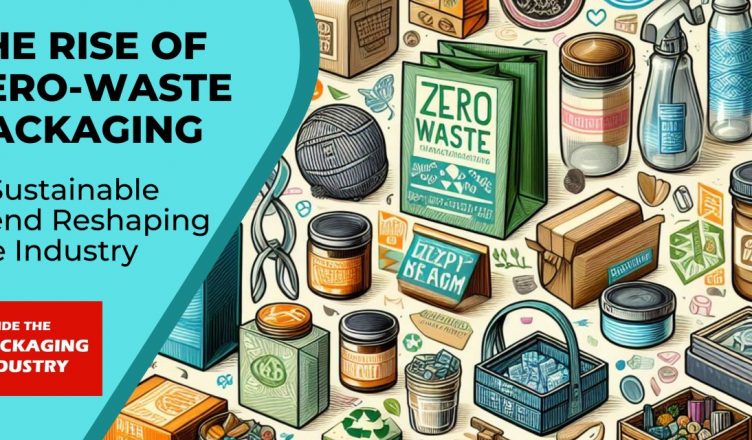Are you tired of excessive packaging that harms the planet? Zero waste packaging products offer an effective solution. These innovative options not only reduce waste but also enhance your commitment to sustainability.
From biodegradable materials to reusable containers, zero waste packaging products help you minimize your environmental footprint. By choosing these alternatives, you contribute to a healthier planet while enjoying the functionality and style you desire. It’s time to embrace eco-friendly solutions that align with your values.
Exploring Zero Waste Packaging Products
In a world increasingly aware of environmental issues, the importance of zero waste packaging products continues to grow. As consumers become more conscious of their choices, businesses are also adapting to meet this demand. This article will explore what zero waste packaging products are, their benefits, various types, and how you can incorporate them into your life or business.
What Are Zero Waste Packaging Products?
Zero waste packaging products are designed to minimize waste at every stage of their lifecycle. This packaging is usable, recyclable, compostable, or reusable, helping to reduce the amount of waste that ends up in landfills and oceans. Here’s a closer look at the key attributes of zero waste packaging:
- Reusable: These products can be used multiple times, reducing the need for single-use packaging.
- Recyclable: Made from materials that can be recycled, allowing them to be processed into new products.
- Compostable: These products break down naturally in a compost environment, returning nutrients to the soil.
- Biodegradable: They decompose naturally without leaving harmful residues but may take longer than compostable items.
- Minimalistic Design: Packaging that uses less material contributes to less waste overall.
Understanding the fundamentals of zero waste packaging lays the groundwork for its benefits and applications.
The Benefits of Zero Waste Packaging Products
Switching to zero waste packaging offers various benefits, both for the environment and businesses:
Environmental Benefits
– **Reduces Landfill Waste:** By producing less waste, we can decrease the amount of rubbish that goes into landfills.
– **Conserves Resources:** Using less material helps conserve natural resources, such as trees, water, and fossil fuels.
– **Encourages Sustainability:** Zero waste packaging promotes a culture of sustainability and responsible consumption.
Economic Benefits
– **Brand Loyalty:** Businesses that adopt eco-friendly practices often see increased loyalty from environmentally conscious consumers.
– **Cost Savings:** Over time, using reusable or recyclable packaging can lead to cost savings in materials and disposal fees.
– **Competitive Advantage:** As more consumers seek sustainable options, businesses can differentiate themselves by offering zero waste packaging.
Health Benefits
– **Less Chemical Exposure:** Many traditional packaging materials contain harmful chemicals. Switching to safe materials protects consumers.
– **Food Safety:** Compostable or recyclable materials reduce the risk of contamination, ensuring food safety.
Types of Zero Waste Packaging Products
Zero waste packaging encompasses a variety of materials and products. Here are some popular options you can find:
Glass Containers
Glass is a durable and versatile packaging option that can be reused or recycled indefinitely. It’s perfect for food items, beverages, and even personal care products.
– **Pros:** Non-toxic, reusable, recyclable.
– **Cons:** Heavy and breakable.
Metal Packaging
Metal containers, such as aluminum cans or tin cans, are excellent options. They are highly recyclable and can be reused multiple times.
– **Pros:** Lightweight, recyclable, often made from recycled materials.
– **Cons:** Not suited for all products.
Paper and Cardboard
These materials are biodegradable and compostable, making them ideal for packaging. Look for products made from recycled paper.
– **Pros:** Biodegradable, recyclable, lightweight.
– **Cons:** Can become damaged if wet.
Bamboo and Other Plant-Based Materials
Bamboo is a popular choice for packaging due to its strength and rapid growth. Other plant-based materials, like cornstarch, are also gaining traction.
– **Pros:** Renewable, biodegradable.
– **Cons:** May not be as durable as plastic.
Compostable Bioplastics
These materials break down in compost conditions, making them an eco-friendly alternative to traditional plastics.
– **Pros:** Can help reduce plastic pollution.
– **Cons:** Requires specific composting conditions.
Reusable Bags and Wraps
Replacing single-use plastic bags with reusable ones is an easy switch. Cloth bags, beeswax wraps, and silicone bags can help reduce waste effectively.
– **Pros:** Durable, reusable, often made from sustainable materials.
– **Cons:** Initial investment might be higher than single-use options.
How to Choose Zero Waste Packaging Products
When considering zero waste packaging, it’s essential to evaluate several aspects:
Material Quality
Choose materials that are durable and suitable for your specific needs. Look for certifications indicating sustainability, such as FSC (Forest Stewardship Council) for paper products.
Lifecycle Analysis
Evaluate the entire lifecycle of the packaging. Consider how it is produced, transported, used, and disposed of.
Cost-Effectiveness
While some zero waste options may have a higher upfront cost, factor in their longevity and potential savings over time. Reusable products often save money in the long run.
Consumer Demand
If you run a business, consider what your customers want. Many consumers actively seek out brands with sustainable practices. Tailoring your packaging to meet this demand can enhance customer satisfaction.
Local Availability
Opt for local suppliers when possible. This reduces carbon emissions associated with transportation and often supports your community.
Implementing Zero Waste Packaging in Your Life
Making the shift to zero waste packaging is easier than you think! Here are some practical steps you can take:
Start Small
– **Select One or Two Areas:** Focus on one aspect of your life, such as grocery shopping or gifts.
– **Gradually Introduce New Products:** Incorporate reusable bags or glass containers into your routine step by step.
Educate Others
Share your knowledge about zero waste packaging with friends and family. You can host a small workshop or simply discuss the benefits over coffee.
Support Sustainable Brands
Choose to purchase from businesses that prioritize zero waste packaging. This encourages more companies to adopt sustainable practices.
Get Creative
Think outside the box when it comes to packaging! For gifts, consider using newspaper or fabric wraps, or even gifting items in a reusable container.
Zero Waste Packaging for Businesses
If you run a business, transitioning to zero waste packaging can be highly beneficial. Here are some strategies to consider:
Conduct a Packaging Audit
Examine the current packaging materials used in your products. Identify areas for improvement, focusing on reducing waste and switching to sustainable options.
Engage Your Customers
Inform your customers about your efforts toward sustainability. This can be done through social media, newsletters, and labeling on products.
Collaborate with Suppliers
Work with your suppliers to source sustainable materials. Many suppliers are becoming increasingly aware of the demand for zero waste options.
Implement a Return Program
Encourage customers to return packaging to be reused or recycled. Offering incentives can motivate more people to participate.
Overcoming Common Challenges
Transitioning to zero waste packaging products can come with challenges. Here are some common issues and solutions:
Higher Costs
While zero waste options may initially seem expensive, consider the long-term savings. Reusable items reduce the need for continuous purchases.
Availability of Products
Some zero waste packaging options may not be readily available in your area. You can source these products online or through specialty stores.
Consumer Education
Many consumers may not understand the importance of zero waste packaging. Providing clear information about the benefits can help swing their purchasing decisions.
Compliance and Regulations
Check local regulations regarding packaging to ensure that your choices align with laws and guidelines.
Future of Zero Waste Packaging
The future looks bright for zero waste packaging. As more people become aware of environmental challenges, demand for sustainable options will likely continue to rise. Here are some trends to watch:
Innovative Materials
Scientists and companies are working on new biodegradable materials to replace traditional plastics. Expect to see more plant-based packaging options emerging.
Technology Advancements
Advancements in technology are making recycling and composting easier, which could increase the viability of zero waste packaging.
Consumer Activism
With more consumers advocating for sustainable packaging, businesses will feel the pressure to adapt. Organizations and groups pushing for eco-friendly practices can lead to substantial changes in the market.
In conclusion, zero waste packaging products represent an essential shift towards more sustainable practices that benefit our environment, economy, and health. By making conscious choices in our packaging solutions, we can significantly reduce waste and contribute to a cleaner planet for future generations. Embracing zero waste packaging is not just a trend; it’s a necessary step towards sustainability that individuals and businesses alike should prioritize.
This zero-waste packaging is made from bamboo
Frequently Asked Questions
What are the benefits of using zero waste packaging products?
Using zero waste packaging products significantly reduces environmental impact by minimizing waste sent to landfills. These products often incorporate sustainable materials, which means they degrade naturally and do not contribute to pollution. Additionally, opting for zero waste solutions can enhance a brand’s image, appealing to consumers who prioritize sustainability. It also encourages a circular economy by promoting reuse and recycling, ultimately conserving resources and energy.
How can businesses implement zero waste packaging strategies?
Businesses can implement zero waste packaging strategies by first assessing their current packaging materials and identifying areas for improvement. They can then research and source sustainable packaging options, such as biodegradable, compostable, or reusable materials. Collaborating with suppliers who specialize in eco-friendly packaging can also help. Moreover, educating consumers on proper disposal or reuse methods reinforces the commitment to sustainability and can drive customer loyalty.
What materials are commonly used in zero waste packaging?
Common materials used in zero waste packaging include organic cotton, recycled paper, glass, metal, and biodegradable plastics made from plant-based sources. These materials are chosen for their ability to decompose naturally or be reused multiple times without harming the environment. Brands often seek materials that have a lower carbon footprint and can be easily recycled or composted at the end of their life cycle.
How do consumers choose zero waste packaging options?
Consumers can choose zero waste packaging options by looking for certifications, labels, or branding that highlight sustainability. They should consider products that prioritize reusable, recyclable, or biodegradable packaging. Additionally, reading product descriptions and researching the company’s packaging practices can provide insight. Engaging with brands on social media or through reviews might also reveal their commitment to zero waste initiatives, helping consumers make informed choices.
What challenges do companies face when switching to zero waste packaging?
Companies face several challenges when switching to zero waste packaging, including higher initial costs associated with sourcing sustainable materials. They might also experience difficulties in finding suppliers who can meet their needs for eco-friendly products. Training employees and educating consumers about new packaging methods can require time and resources. Additionally, companies may need to adjust their production processes to accommodate new materials, which can involve significant operational changes.
Final Thoughts
Zero waste packaging products play a crucial role in reducing environmental impact. These eco-friendly options minimize waste and promote sustainability in our everyday lives. By choosing zero waste packaging, consumers contribute to a healthier planet and encourage brands to adopt greener practices.
Incorporating zero waste packaging products into your routine not only benefits the environment but also inspires others to make conscious choices. As more people embrace sustainable alternatives, we can collectively move towards a circular economy. Reducing our reliance on single-use plastics will lead to a cleaner, more sustainable future for everyone.

